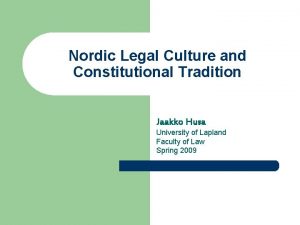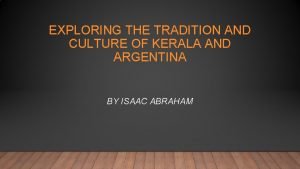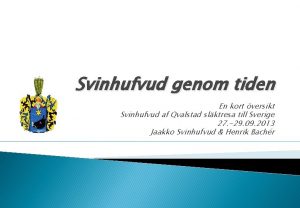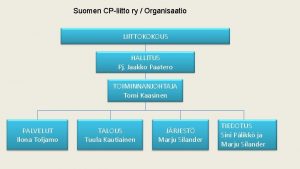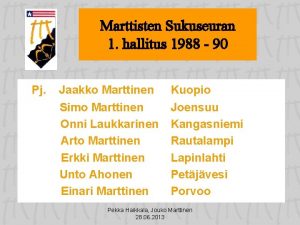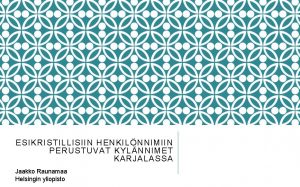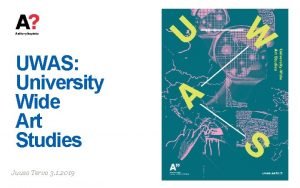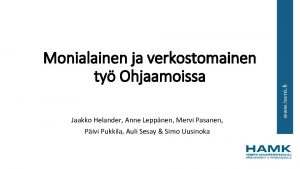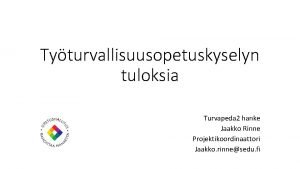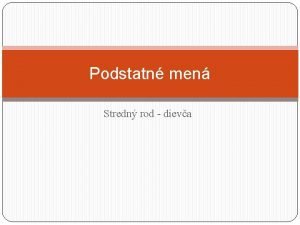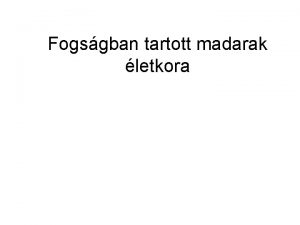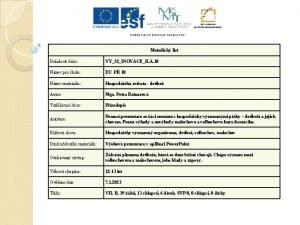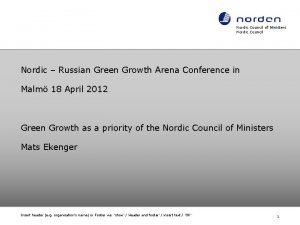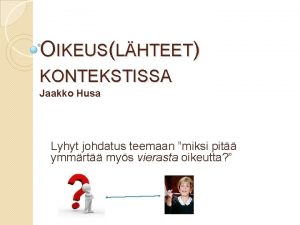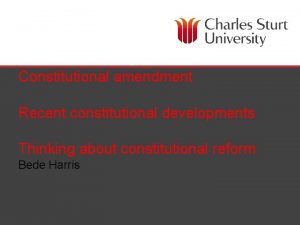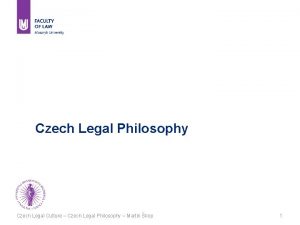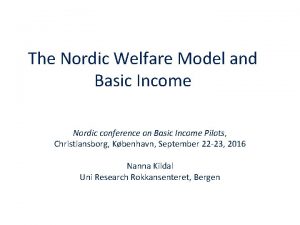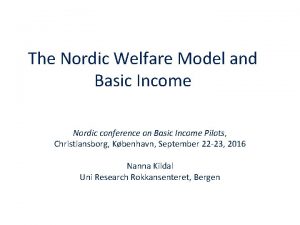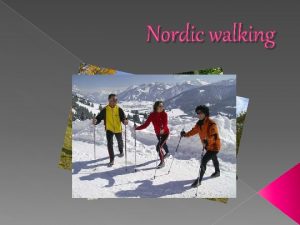Nordic Legal Culture and Constitutional Tradition Jaakko Husa
















- Slides: 16

Nordic Legal Culture and Constitutional Tradition Jaakko Husa University of Lapland Faculty of Law Spring 2009

Contents 1) Historical and general overview of Nordic law – shortly (Note: Iceland not included) 2) Inner divisions and differences within Nordic law: East vs. West -shortly 3) Nordic Constitutions – Some Basic Features 4) Finnish Constitution Development Distinctive features Some thoughts…

Overview l Part of Europe, but peripheral in a sense – l l l not common law, not really civil law Denmark and Norway united 1380 -1814 Norway in union with Sweden 1814 -1905 Sweden and Finland together until 1809 Finland part of Russia (Autonomy + Swedish Constitution) Finland became independent 1917

Overview l Legal family? – – – – Separate sub-group of civil law Closer to continental law than common law No stare decisis, courts apply law not create, written legal system, public/private law division But: Not overtly theoretical, realism/pragmatism No large codes in civil law (separate smaller acts) No sharp distinction between civil law and commercial law Roman law (ius commune) effects not so visible no “scientification” of law takes place in 19 th century

Inner divisions l l Danish and Norwegian law unified in 17 th century = Western group/Copenhagen as centre Swedish and Finnish law gain common basis 1734 = Eastern group/Stockholm as centre – – l l West: no separate administrative courts, judge-carrier reminds common law judge’s carrier East: separate administrative courts, judges are “public officials” Others monarchies, Finland Republic (reluctant? ) Spilling over Nordic edges: – a) Norway: most American (Høyesterett, overtly practical)? , b) Finland: most German ?

Nordic Constitutions l Denmark – l Norway – l Grunnlov 1814, constitutional monarchy, unitary state, parliamentary system, judicial review, not an EU member Sweden – l Grundloven 1953 (1849), constitutional monarchy, unitary state, parliamentary system, judicial review? , EU member 1972 Regeringsform 1974 (main), constitutional monarchy, unitary state, parliamentary system, de jure weak judicial review, EU member 95 Finland – Perustuslaki 2000 (1919), republic, unitary state (Åland islands? ), parliamentary system with president, weak judicial review, EU member -95

Nordic Constitutions – Constitutionality Control ______________________________ “Problem” Norway Sweden Finland Denmark ______________________________ Point of Time R R P+R R Control organ C C+NC NC+C C Nature of Control K K L+A K Organization H H S(+H) H Basis of Control A+D N N+ D Outcome F I I I _______________________________ Symbols: R=Ex post facto, P=Preventive, C=Court, NC=Non-Court (other public organ), K=Concrete, L=Abstract, H=De-centralized, S=Centralized, D=Doctrine, N=Norm (codified rule), A=Court practice, I=invalidating in a (judicial) case at hand and, F=nullification de facto.

Nordic Constitutions – Common Elements of Constitutional Culture Parliamentary system with mixture of separation of powers Consensual democracy (avoidance of open conflicts in politics, multi-party system). Cautious systems of judicial review (judicial selfrestraint, Norway? ) Respect for the will of the legislator (avoidance of conflicts, great significance of travaux) Constitutional conformity interpretation No separate Constitutional Courts

Nordic Constitutions – Common Elements of Constitutional Culture… Combination of written and unwritten rules and principles (Constitutions not only codified, contain also conventional elements) Elements of constitutionalism (respect of Constitution within parliamentary frames; effective lex superior, i. e. Constitutions are not political manifestos nor collections of dead rules) Pragmatic and practical legal style (argumentation, although, grammatical also teleological and intentional, the nature of argumentation is not "heavy" as in Germanic law, nor so cryptic as in French law, to some extent a casuistic nature) Flexibility of Constitution (although written “Basic Laws”, alteration takes place in various of ways; formal amendment, customs, conventions and case law)

Finnish Constitution - Development l Swedish period ca. 1200 -1809 – – – l l 1680 -1718 Age of the Sovereign Rule 1718 -1772 Age of Freedom 1772 -1809 Gustavian period Russian/Autonomy period 1809 -1917 Independency 1917– – – Civil war 1918 Form of Government 1919 Eurostate & constitutional reform 1992 -

Distinctive Features – Sources Authoritative sources: l Constitution Act, Acts of Parliament (laki), lower Decrees (asetus) also have generally binding legal force (issued by Government, President or Ministry) Semi-authoritative sources: l Statements of Constitutional Committee of the Parliament (Eduskunnan perustuslakivaliokunta), preparatory works of legislation (lainsäädännön esityöt), key-decisions of Supreme Courts Permitted sources: l Praxis by constitutional actors (convention-type rules/principles created by Government, President, PM, Parliament), general principles of constitutional law, legal dogmatics, constitutional morality, and comparative arguments Other sources: l EU law & ECJ’s case law, ECHR& ECt. HR’s case law

Distinctive Features – Parliamentarism with President Constitution President Parliament Governme nt Courts

Distinctive Features – Flexibly Rigid l Basic distinction: flexible vs. rigid constitution – l l E. g. UK or New Zealand vs. US or Germany De jure Finnish Constitution is rigid (Section 73 CA) De facto Finnish Constitution is flexible – – – Changing trough interpretation Customs and conventions Exceptive Acts “flexibly rigid”

Distinctive Features – Institution of Exceptive Act (poikkeuslaki) l l Exceptive Act means a partial displacement of the content of the written constitutional document, without changing the text meanwhile. Doctrine was crafted not to undermine the Constitution but rather simultaneously to respect it and to create needed flexibility – – Doctrine is not close to the infamous doctrine of exceptive laws used by the Third Reich meaning of 19 th century Year 2000 doctrine was modified: ”limited exception” (rajattu poikkeus)

Some Thoughts… Constitutional luck is important: - Gustavus III’s Form of Government was so ruler-friendly that the Russian Tsar could accept it in 1809 - out of the turmoil of 1918 as a republic that at least had the formal dimensions of a democratic state - when the CA of 2000 was drafted and prepared that the President was at that time politically so weak that the reform was able to take place etc. de Tocqueville has pointed out: ‘A lawgiver is like a man steering his route over the sea. He, too, can control the ship that bears him, but he cannot change is structure, create winds, or prevent the ocean stirring beneath him”

Some Thoughts… l Collisions: – reformist vs. conservative l – formal vs. non-formal l – Nordic mentality but resistance of haste changes in constitutional field rigid Constitution Act but other forms to reach flexibility inward-looking vs. international l wanting to hold to national sovereignty-principle but practically giving in to EU/ECHR
 Jaakko husa
Jaakko husa Kerala culture and tradition
Kerala culture and tradition Tradition vs culture
Tradition vs culture Reluktanssimoottori
Reluktanssimoottori Brother john
Brother john Svinhufvud släktträd
Svinhufvud släktträd Jaakko paatero turku
Jaakko paatero turku Jaakko marttinen
Jaakko marttinen Jaakko raunamaa
Jaakko raunamaa Prof. jaakko timonen
Prof. jaakko timonen Jaakko helander
Jaakko helander Jaakko rinne
Jaakko rinne Slovo nadřazené ke slovu slepice husa kachna
Slovo nadřazené ke slovu slepice husa kachna Kozľa vzor
Kozľa vzor Vzor srdce slova
Vzor srdce slova Selyemtyúk húsa
Selyemtyúk húsa Husa býložravec
Husa býložravec
